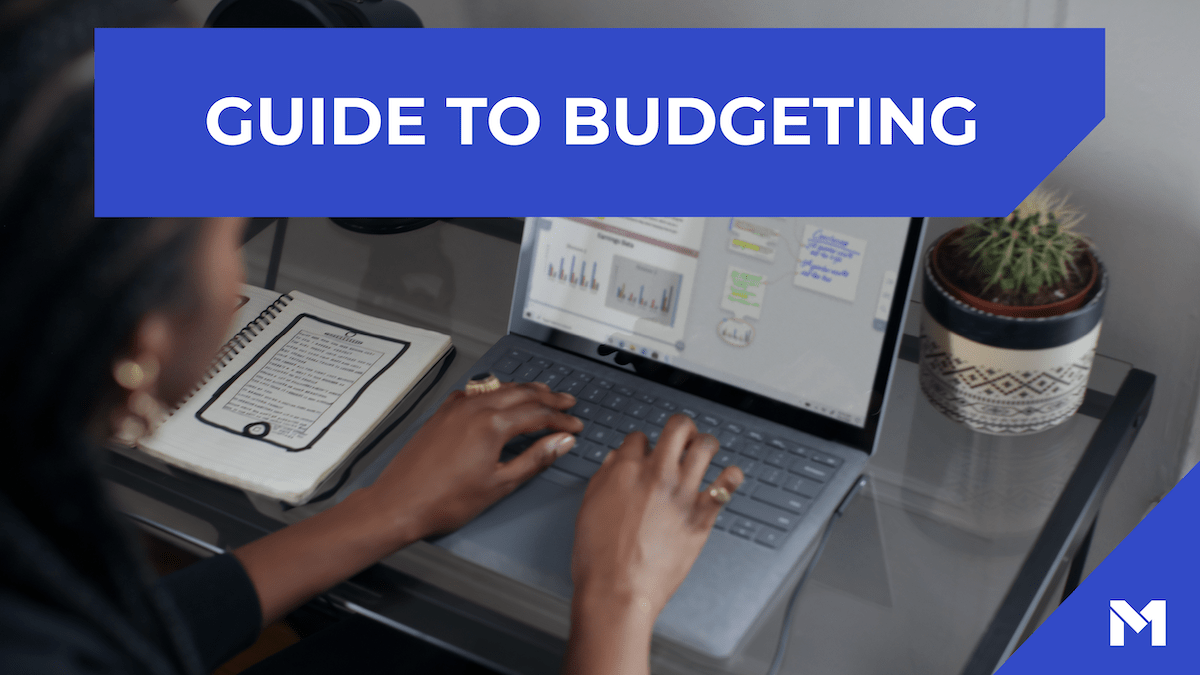Guide to budgeting for long-term financial wellness

Budgeting benefits everyone working toward financial wellness, from the experienced investor maximizing their retirement savings to the college student trying to figure out how to stretch a dollar. It allows you make smart financial decisions by tracking how much money you bring in and how much you spend. It also helps you plan for financial goals and save for retirement.
Budgeting is a fundamental part of managing your money, but it involves more than a monthly breakdown of income and expenses.
In this guide, we’ll cover the following topics to help you update your current budget or establish one for the first time.
- What is budgeting?
- Why is budgeting important?
- Budgeting myths
- Budgeting methods
- How to build a personal budget
- How to stick to your budget
What is budgeting?
Budgeting is a financial plan for your hard-earned money. Think of it like an itinerary for a road trip. It allows you to create, track, and achieve your goals to reach a certain financial destination.
Customizable budgets can be as basic as a few categories or as detailed as a color-coded spreadsheet where you meticulously track each purchase. Most budgets include the following information:
- Income (fixed and variable)
- Expenses (fixed and variable)
- Non-monthly expenses
- Savings goals
- Retirement planning
- Investing
Tracking this information with a budget could help you work toward your specific financial goals.
Why is budgeting important?
Budgeting is an important part of a healthy financial life. It looks different for everyone, but it’s a way to organize personal finances, notice spending and savings trends, and work towards the financial future you want. However, most budgets achieve two key goals:
1. It helps you identify your money habits.
A budget forces you to look at where your money went at the end of every month and have honest conversations about your habits. This can help identify bad habits including overspending, not saving enough, or not having the correct allocations for each section of your budget.
Once you identify those bad habits, you can focus on building strong habits like continued financial education, better control of emotional spending, and adopting a growth mindset.
2. It keeps you focused on your financial goals.
A common money goal is maximizing your retirement savings. A budget can help simplify projections for how much you need to save for retirement and put away money every month. The same is true with saving for college, eliminating debt, building an emergency fund, and meeting your financial goals.
On top of all of that, budgeting helps you to avoid feeling overwhelmed by financial decisions. According to the American Psychological Association, 72 percent of Americans reported feeling stressed about money at least some time in the prior month.
Having a clear map of where your money goes allows you to have peace of mind. This mental clarity can make it easier to plan your financial goals and eliminate distractions along the way.
Take control of your spending, investing, and borrowing with M1 >>
Budgeting myths for personal finances
Understanding why and how to budget is just as important as addressing the reasons why people avoid budgeting. Here’s a list of common myths you may hear about budgeting — and why they aren’t true.
“Budgeting is too much work.”
Saying budgeting is too difficult is akin to saying exercise is tough. The work you put into budgeting leads to a better understanding of your money and habits. Think of it as the necessary financial sweat equity to build a strong portfolio.
Small increments of structure, time, and clarity are enough to track spending and keep up the momentum. Plus, with a wide variety of budgeting apps and websites, it’s easier than ever to maintain your budget with minimal work.
“I don’t need to budget because my finances are in good shape.“
If you’re in good financial shape, wouldn’t you want to take every step possible to keep it that way? Combining budgeting and a regular audit of your finances can help you stay the course.
On top of that, budgeting can be vital to help understand what money habits keep you financially fit. It also helps protect you from lifestyle creep, which dangerously increases your expenses each time you get a raise or your net worth grows.
“I barely have enough money to cover my necessities.”
Budgeting can eliminate financial stress by showing you exactly where your money winds up. It can also help you stay on top of due dates for bills and start building an emergency fund.
Also, it’s important to do things that you find joy in even when things are tight financially. When you know you’re staying inside of each category in your budget, the guilt of spending money on yourself is removed.
“I don’t have the discipline.”
Stop shortchanging yourself. You can do it!
Most people overestimate the motivation needed to find financial success. It’s more about building tiny habits that work for you and sticking with them long term. In finance, that means motivation will come and go. When it does, the progress we’ve made toward establishing financial goals will go with it. That is unless we’ve established a fail-safe system to prevent that.
“I don’t know where to start.”
No need to worry — that’s why we built this guide. By the end, you’ll know all about popular budgeting methods, tips to stay on track, and how to budget for financial goals.
Budgeting methods for monthly expenses
Budgets are not one-size-fits-all. The approach you take depends on many factors, including monthly income, cash flow, savings, debt, and more.
We’ll focus on a few popular budgeting frameworks. These ways of thinking about budgeting have kept many people motivated to track their finances. As you read about some of these, look for the ones that would motivate you personally, because an essential factor in choosing a budget is picking one you’ll stick with month after month.
Zero-based budgeting
Also known as zero-sum budgeting, zero-based budgeting is a method where every single dollar of your income is assigned to a category.
Let’s look at an example:
- Monthly take-home income: $2,000
- Rent: $700
- Utilities: $200
- Groceries: $300
- Savings: $300
- Loan payment: $300
- Entertainment/eating out: $200
In this example, every dollar is assigned to a specific spending category.
This is a wonderful budgeting process if you’re hoping to get a better sense of how you use your money each month. It keeps you cognizant of your cash flow by accounting for every dollar, so you’ll be less likely to spend what you don’t have.
This method is entirely customizable, so it can be less overwhelming for first-time budgeters.
50/30/20 budget
One of the most popular budgeting methods is the 50/30/20 budget. This budget has you break your monthly post-tax income into three categories:
- 50% of your income is dedicated to needs
- 30% is dedicated to wants
- 20% is dedicated to savings
People enjoy this method because it sets frameworks for everyday needs, while still dedicating a major percentage of your income to things you enjoy doing and savings for your future. In that way, many people find it less restrictive than traditional budgeting.
Needs – 50%
These are the things that you can’t do without: food, housing, utilities, transportation, insurance, and anything else you need to live your life. These are expenses that you will have to pay regardless of how your finances fluctuate.
Wants – 30%
This is where you can have some fun with your hard-earned dollars. Whether you’re spending on a vacation to explore the world, checking out a new restaurant, or streaming on ten different media platforms, it’s important to do things you enjoy. This prevents budgeting burnout.
Even though your Netflix or Peloton subscriptions seem like a need at this point, be sure to budget all non-essential expenses under your wants. Learn more about distinguishing between wants and needs.
Savings and debt – 20%
The average American saves less than 5% of their income, and a major reason why is a lack of budgeting. Even though it can be enticing to put a higher percentage into wants, future you will be very excited that you set aside 20% of your income for savings.
This starts with setting up an emergency fund. Financial experts say that you should multiply your expenses by at least three months and save that amount as emergency funds. This will protect you against unexpected expenses, such as medical bills or home repairs. After that’s set up, you can shift focus to retirement savings. Build your retirement strategy and maintain it with an IRA, 401(k), or an individual investing account. Be sure to take advantage of any employer 401k match.
However, this 20% of your budget isn’t just for savings — it’s also for paying off debt. This is a necessary part of budgeting, especially since the average American has over $90,000 in debt. Prioritize paying off high-interest debt, such as credit card, student loan, or personal loan debt.
Envelope system budgeting
Traditionally, the envelope system asks you to put cash in physical envelopes that represent each category of your budget. For example, you would have envelopes labeled “mortgage” and “electricity bill” and fill them with the cash needed for that payment each month.
Fans of this system swear by its ability to keep them from overspending and irresponsibly swiping their cards. If you’re not using a budget, it can be easy to overspend because nothing is telling you to stop or that you’re financially overextending yourself. With the envelope system, you know your spending in a category is done for the month when the envelope money is gone.
If there’s money left over at the end of the month, you can either choose to roll it into the next month’s budget for that envelope, move it to another envelope, or use it for wants. This can be a great system for anyone with credit card debt or those looking to curb impulsive spending habits. With the shift to digital banking, you can now use online tools to simulate this approach.
Considerations when creating a budget
Whether you chose one of the popular methods above, or have a unique budget of your own, here are some considerations that work in tandem with all budgets.
Pay yourself first
If you’re looking to prioritize savings and begin investing, this is a crucial step.
Where most budgets see savings as the last step, it’s the first step in our playbook. Called a “reverse budget” by some, this method shifts the focus of traditional budgeting by “paying yourself first” in the form of retirement savings or investments.
If this method sounds right for you, be sure that there are goals tied to the savings such as retirement, a college fund, or hitting a certain number. This will allow you to stay motivated since you’ll be on a savings journey that has a destination.
Automation can also be a great tool when paying yourself first. For example, if you want to allocate 25% of your income to “paying yourself” you can set up rules in your bank account to automatically allocate 15% of that to savings. You can then set up a rule in your brokerage account to take out that additional 10% you’re allocating towards investing.
Discover how simple it is to automate your finances with M1 >>
Understand static vs. flexible budgets
Another consideration when building a budget is deciding between a static and flexible budget.
A static budget is what many people think of as a budget. You set expenses and the income needed to pay for those expenses. Once you calculate these numbers and categories, all you have to do is follow them. However, this method isn’t as flexible, so people with variable income or expenses may struggle to stay on track.
A flexible budget allows you to change things on the fly, which is great for small business owners, freelancers, or people with a side hustle. Many businesses use flexible budgets because of the changing nature of both the revenue they bring in and the expenses they encounter. The downside of a flexible budget is that it takes more time and work to upkeep.
Learn more about static vs. flexible budgets to figure out which one is right for you.
How to build a personal budget
Now that you have the frameworks for popular budgeting methods, let’s go over how to build a budget.
1. Find your net income.
The easiest way to figure out your net income is to look at tax forms. If your job or income has changed, you can multiply your most recent check by the number of times you receive it per year.
For instance, let’s say you receive a check for $2,000 every payday. You get paid on the 1st and 15th of every month, which means you get paid 24 times a year.
$2,000 x 24 paychecks = $48,000 in net income
If your income isn’t the same each month, it’s called variable income. Budgeting on a variable income is more involved, but it’s certainly manageable. Here’s how to approach it:
- Prioritize necessities. This includes rent, food, transportation, and anything else needed to live your daily life.
- Set a percentage aside in savings. Consider automating this process to alleviate the stress of saving.
- Pay yourself. If you don’t have enough savings to cover three months of expenses, consider sending part of your direct deposit into a savings account.
2. List your expenses.
Your expenses will fall in one of three buckets: fixed expenses, dynamic expenses, and discretionary expenses.
- Fixed expenses: Bills that stay the same each month, usually housing and some utilities. Think: rent, internet, and insurance.
- Dynamic expenses: Bills that change from month to month. Think: gas, electricity, and groceries.
- Discretionary expenses: Anything that is optional or for fun. Think: subscriptions, vacations, and going out to eat.
3. Set SMART goals.
SMART is an acronym that lays out important guidelines for the financial goals you set. It stands for specific, measurable, achievable, realistic, and time-bound. People use this framework because it provides clarity around financial planning and achieving goals.
Imagine one of your financials goals is to save more money this year. Rather than just intending to save up more money, you can use SMART goals to save $6,000 by the end of the year.
- Specific – I want to save $6,000 in one year.
- Measurable – I need to save $500 per month to stay on track.
- Achievable – I have 12 months to complete this goal.
- Realistic – I have budgeted and know I can allocate $500 a month in savings.
- Time-bound – I have until December 31 to hit my goal.
4. Pick a budgeting method.
Once you’ve set your goals, it’s time to choose the method that works best for you.
Choose a popular method: You can use one of the methods we laid out above such as the 50/30/20 budget, zero-based budgeting, the envelope system, or pay yourself first.
Tried and true spreadsheet: The simplicity and flexibility of old-school spreadsheets work best for some people. You can customize percentages and create your budget by opening Excel or Sheets.
Use a budgeting app or website: Some people love the tools that budgeting apps offer and use them to track all their spending. Many of these tools require a subscription but offer great ease of use. These apps connect to your bank account and track your spending for you.
Let’s look at some popular platforms:
- Mint – Perhaps the most popular budgeting app, Mint automatically puts your spending into customizable categories. You can sync it with many different accounts, including checking, savings, credit cards, loans, investments, and bills.
- YNAB – This $15/month app is a great option for hands-on budgeters. YNAB follows the zero-based budgeting method to account for every dollar you earn.
- Goodbudget – This free budgeting app doesn’t connect to your accounts, so it’s best for users who want to enter information manually. Goodbudget is based on the envelope budgeting system, so it may work best for fans of that method.
How to stick to your budget
No matter what method works best for you, keeping track of your income and expenses will empower you to have a greater degree of financial control and stability.
Find your why.
Why are you budgeting? Is it to build up a college fund for your kids? Is it to erase credit card debt? Is it to take control of your finances? Whatever the reason may be, identify it and remember it. If you’re budgeting with a partner, communicate these reasons and share the purpose for tracking your living expenses.
Re-evaluate your budget quarterly (or more often).
Life happens, and personal finances can change during a year. Maybe your income has shifted, you leased a new vehicle, or you took up a new hobby. Whatever the circumstance is, you want to adjust your budget accordingly. A scheduled quarterly check-in can help you identify where changes need to be made. Don’t be afraid to shift priorities so you can reasonably reach your goals.
Let automation do the work for you.
Automating your finances can help you prioritize savings, be disciplined and consistent in your investing, and avoid missing payments. (Don’t forget about lowering your financial stress and increasing your financial efficiency). You can set up smart transfer rules for your money and let the automation take care of the rest.
Try different budgeting methods.
Whether budgeting, exercising, or eating the right foods for you, there’s no harm in trying different programs until you find the one that suits you best. Think of it like test driving a car. If the first pick isn’t right for you, you wouldn’t give up on getting a car. In the same way, don’t give up on budgeting just because you ran into roadblocks or bumps on your first attempt.
Budgeting for your financial goals
Whether this is your first-ever budget, or you’re a seasoned pro who’s looking to refresh their methods, building a budget is a victory. You’re taking an important step on the journey towards financial wellness.
Like most worthwhile endeavors, getting a budget right can take some time. You may have to adjust it over the course of a few months. But testing will allow you to find the methods that set you up for long-term financial success.
For more educational resources, learn how to create financial goals or read a few of our favorite personal finance books.
Editor’s note: This post was originally published on Jan 5, 2022 and has been updated for comprehensiveness.
M1 and its affiliates do not provide tax, legal, or accounting advice. This material has been prepared for informational purposes only. It is not intended to provide, and should not be relied on for, tax, legal or accounting advice. You should consult your own tax, legal, and accounting advisors before engaging in any transaction.
- Categories
- Planning
- Tags



